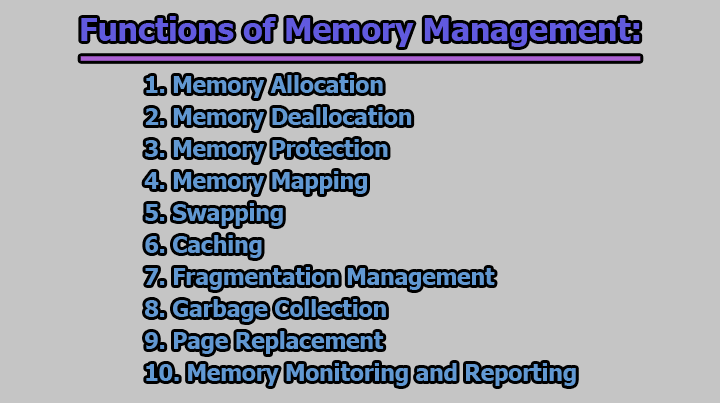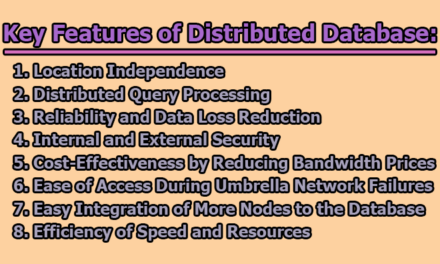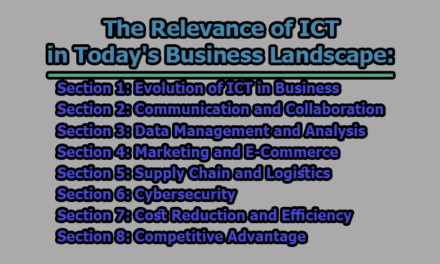In the realm of computer systems, memory management plays a pivotal role in ensuring efficient and effective utilization of a computer’s memory resources. Memory, in this context, refers to the volatile data storage that a computer uses to store and retrieve data actively in use. Proper memory management is crucial for the smooth operation of computer systems, as it directly impacts performance, stability, and overall user experience. In this exploration aims to delve into the Importance and multifaceted functions of memory management in the digital landscape. From understanding the basics of memory to the intricacies of managing it at both hardware and software levels, this discussion will shed light on the critical role memory management plays in modern computing environments.
The Basics of Memory:
Before delving into the complexities of memory management, it is essential to grasp the fundamental concepts of memory in a computer system. Memory can be broadly classified into two main types: primary (RAM) and secondary (storage devices like hard drives and SSDs). Primary memory is volatile and used for actively running programs and storing temporary data, while secondary memory provides non-volatile storage for long-term data retention.
Types of Memory:
- RAM (Random Access Memory): RAM is a type of volatile memory that the computer uses to store data actively being used or processed. It allows quick read and write access, making it ideal for running applications and processes.
- ROM (Read-Only Memory): Unlike RAM, ROM is non-volatile memory that retains its content even when the power is turned off. It contains firmware and is mainly used to store the computer’s basic input/output system (BIOS).
- Cache Memory: Cache memory is a small-sized type of volatile computer memory that provides high-speed data access to the processor and stores frequently used computer programs, applications, and data.
Memory Hierarchy:
Modern computer systems often implement a memory hierarchy, which consists of multiple levels of memory with varying speeds and sizes. This hierarchy is designed to optimize data access and retrieval, with faster but smaller memory levels closer to the CPU.
- Registers: The fastest and smallest type of memory directly integrated into the CPU. Registers store data that the processor is currently using or processing.
- Cache: Located between the main memory (RAM) and the CPU, the cache stores frequently accessed data to reduce the time it takes for the CPU to fetch information.
- Main Memory (RAM): This is the primary volatile memory used for active data storage. It is faster than secondary storage but smaller than secondary storage devices.
- Secondary Storage: Non-volatile storage devices like hard drives and SSDs are used for long-term data storage, including the operating system, applications, and user data.
Understanding this memory hierarchy is essential for appreciating the challenges and requirements of memory management.
Importance of Memory Management:
Memory management is a necessary aspect of computer systems, and its importance is evident in various aspects of computing. The following points highlight the key reasons why memory management is indispensable:
1. Resource Utilization: Efficient memory management ensures optimal utilization of the available resources. By allocating and deallocating memory as needed, the system can make the best use of its memory capacity, preventing unnecessary wastage.
2. Performance Optimization: Well-managed memory contributes significantly to system performance. By minimizing data access times and ensuring the availability of required resources, memory management helps in speeding up the execution of programs and processes.
3. Multitasking Support: In a multitasking environment, where multiple programs run concurrently, memory management is crucial. It enables the seamless switching of contexts between different applications, ensuring that each program gets the necessary memory resources for execution.
4. Reliability and Stability: Proper memory management enhances the reliability and stability of computer systems. Memory leaks and inefficient resource allocation can lead to system crashes and instability, negatively impacting the user experience.
5. Security: Memory management is also tied to system security. Unauthorized access to or modification of memory locations can lead to data breaches and compromise system integrity. Memory protection mechanisms are implemented to prevent unauthorized access and enhance system security.
6. Scalability: As the demands on a computer system grow, effective memory management becomes essential for scalability. Systems need to adapt to varying workloads and resource requirements, and efficient memory management facilitates this scalability.
7. Cost-Effectiveness: Optimized memory management contributes to cost-effectiveness by reducing the need for excessive hardware resources. Efficient use of memory allows systems to achieve better performance without the necessity for constant upgrades in terms of RAM capacity.
In essence, memory management is the backbone of a well-functioning computer system, influencing its performance, reliability, and adaptability.
Functions of Memory Management:
Memory management involves a spectrum of functions that operate at both the hardware and software levels. These functions collectively ensure that memory resources are effectively utilized and that the system operates smoothly. Let’s explore the primary functions of memory management:
1. Memory Allocation: Memory allocation is the process of assigning portions of memory to various programs and processes. It involves dividing the available memory into segments and allocating these segments to different tasks. There are various allocation strategies, including fixed partitioning, dynamic partitioning, and paging.
- Fixed Partitioning: Divides memory into fixed-sized partitions, and each partition is allocated to a specific task. This method is simple but can lead to inefficient use of memory.
- Dynamic Partitioning: Allocates memory dynamically based on the actual size of the programs. It is more flexible than fixed partitioning but requires more sophisticated management.
- Paging: Divides both physical and logical memory into fixed-sized pages. This allows for more efficient use of memory, as pages can be allocated and deallocated as needed.
2. Memory Deallocation: Memory deallocation, also known as freeing or releasing memory, occurs when a program or process no longer needs the allocated memory. Proper deallocation is crucial to prevent memory leaks, where allocated memory is not released, leading to a gradual depletion of available memory.
3. Memory Protection: Memory protection mechanisms safeguard the integrity of a computer system by preventing unauthorized access to memory locations. This involves setting access permissions for different memory segments to control which parts of memory a program can read from or write to.
4. Memory Mapping: Memory mapping involves mapping logical addresses to physical addresses. In systems that use virtual memory, the logical addresses used by programs are mapped to physical addresses in the actual memory or, when necessary, to secondary storage.
5. Swapping: Swapping is a technique used to manage memory by temporarily transferring data from the main memory to secondary storage (usually the hard drive) when the system’s memory is full. This frees up space in the main memory for other processes, and the swapped-out data can be brought back when needed.
6. Caching: Caching involves storing frequently accessed data in a smaller, faster memory (cache) to reduce access times. This is particularly important for improving the speed of data retrieval, especially for the CPU.
7. Fragmentation Management: Fragmentation can occur in memory, leading to inefficient use of available space. Memory management addresses fragmentation by compacting memory or using strategies to minimize its impact. There are two main types of fragmentation: external fragmentation, where free memory is scattered, and internal fragmentation, where allocated memory is not fully utilized.
8. Garbage Collection: In programming languages with automatic memory management (such as Java or Python), garbage collection is a crucial function. It involves identifying and reclaiming memory occupied by objects that are no longer in use, freeing up resources and preventing memory leaks.
9. Page Replacement: In systems using paging, when a page of data needs to be brought into memory but there is no available space, a page replacement algorithm selects a page to be removed from memory. This process aims to minimize the impact on system performance.
10. Memory Monitoring and Reporting: Continuous monitoring of memory usage and performance is vital for proactive management. Systems often include tools for reporting memory utilization, allowing administrators to identify potential issues and optimize resource allocation.
In conclusion, memory management is a cornerstone of modern computing, ensuring the efficient and effective use of memory resources in both hardware and software domains. From the basic understanding of memory types and hierarchy to the intricate functions performed by memory management systems, its significance cannot be overstated.
Efficient memory management contributes to resource utilization, performance optimization, multitasking support, system reliability, security, scalability, and cost-effectiveness. The functions of memory management, including allocation, deallocation, protection, mapping, swapping, caching, fragmentation management, garbage collection, page replacement, and monitoring, collectively orchestrate the harmonious functioning of computer systems.
As technology advances and the demands on computer systems evolve, the importance of robust memory management becomes even more pronounced. It is a dynamic field that continues to adapt to new challenges and requirements, playing a pivotal role in shaping the digital landscape we navigate today and into the future.

Library Lecturer at Nurul Amin Degree College










